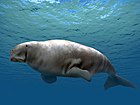Dugongidae
 From Wikipedia the free encyclopedia
From Wikipedia the free encyclopedia
| Dugongidae[1] Temporal range: Late Eocene-Holocene | |
|---|---|
 | |
| A dugong in Marsa Alam | |
| Scientific classification | |
| Domain: | Eukaryota |
| Kingdom: | Animalia |
| Phylum: | Chordata |
| Class: | Mammalia |
| Order: | Sirenia |
| Family: | Dugongidae Gray, 1821 |
| Genera | |
| Dugong | |
Dugongidae is a family in the order of Sirenia. The family has one surviving species, the dugong (Dugong dugon), one recently extinct species, Steller's sea cow (Hydrodamalis gigas), and a number of extinct genera known from fossil records.

Dugongidae's body weight ranges from 217 to 307 kg for juveniles, 334 to 424 kg for subadults, and 435 to 568.5 kg for adults. Oral temperatures for individual dugongs is determined from 24° to 34.2 °C. Heart rate readings are from 40 to 96 bpm and vary between individual dugongs. Respiration rate during the out-of-water phase is from 1 to 33.[2]
Taxonomy[edit]
- Family Dugongidae
- Genus †Anisosiren
- Genus †Caribosiren
- Genus †Indosiren
- Genus †Lentiarenium
- Genus †Kaupitherium[3]
- Genus †Paralitherium
- Genus †Priscosiren[4]
- Genus †Prohalicore
- Genus †Sirenavus
- Subfamily †Halitheriinae
- Genus †Halitherium (nomen dubium)
- Subfamily Dugonginae
- Genus †Bharatisiren
- Genus †Callistosiren[5]
- Genus †Crenatosiren
- Genus †Corystosiren
- Genus †Culebratherium
- Genus †Dioplotherium
- Genus †Domningia
- Genus Dugong
- Species Dugong dugon, dugong
- Genus †Italosiren[6]
- Genus †Kutchisiren
- Genus †Nanosiren
- Genus †Norosiren
- Genus †Rytiodus
- Genus †Xenosiren
- Subfamily †Metaxytheriinae
- Genus †Metaxytherium
- Subfamily †Hydrodamalinae
- Genus †Dusisiren
- Genus †Hydrodamalis
- Species †Hydrodamalis cuestae
- Species †Hydrodamalis spissa[7]
- Species †Hydrodamalis gigas, Steller's sea cow
The genera Eosiren, Eotheroides, and Prototherium have been assigned to Halitheriinae in the past, but recent cladistic analysis recovers these genera as basal to the clade formed by Trichechidae and Dugongidae. Moreover, Halitheriinae is paraphyletic with respect to Dugonginae and Hydrodamalinae, and further use of the name should be discontinued because the type genus is based on a non-diagnostic tooth.[8]
Phylogeny[edit]
References[edit]
- ^ Shoshani, J. (2005). Wilson, D.E.; Reeder, D.M. (eds.). Mammal Species of the World: A Taxonomic and Geographic Reference (3rd ed.). Johns Hopkins University Press. ISBN 978-0-8018-8221-0. OCLC 62265494.
- ^ Lanyon, Janet M., et al (2010). “Physiological Response of Wild Dugongs (Dugong dugon) to Out-of-Water Sampling for Health Assessment.” Aquatic Mammals, vol. 36, pp. 46-58. doi:10.1578/AM.36.1.2010.46.
- ^ Manja Voss & Oliver Hampe (2017). "Evidence for two sympatric sirenian species (Mammalia, Tethytheria) in the early Oligocene of Central Europe". Journal of Paleontology. in press. doi:10.1017/jpa.2016.147.
- ^ Vélez-Juarbe, Jorge; Domning, Daryl P. (2014). "Fossil Sirenia of the West Atlantic and Caribbean region. X. Priscosiren atlantica, sp. nov". Journal of Vertebrate Paleontology. 34 (4): 951. doi:10.1080/02724634.2013.815192. S2CID 85297028.
- ^ Vélez-Juarbe, Jorge; Domning, Daryl P. (2015). "Fossil Sirenia of the West Atlantic and Caribbean region. XI. Callistosiren boriquensis, gen. et sp. nov". Journal of Vertebrate Paleontology. 35: e885034. doi:10.1080/02724634.2014.885034. S2CID 84600341.
- ^ Manja Voss; Silvia Sorbi; Daryl P. Domning (2017). "Morphological and systematic re-assessment of the late Oligocene "Halitherium" bellunense reveals a new crown group genus of Sirenia". Acta Palaeontologica Polonica. 62 (1): 163–172. doi:10.4202/app.00287.2016.
- ^ Furusawa, Hitoshi (1988). A new species of hydrodamaline Sirenia from Hokkaido, Japan. Takikawa Museum of Art and Natural History. pp. 1–73.
- ^ Voss, Manja (2014). "On the invalidity of Halitherium schinzii Kaup, 1838 (Mammalia, Sirenia), with comments on systematic consequences". Zoosystematics and Evolution. 90: 87–93. doi:10.3897/zse.90.7421.
